
The livre tournois was one of numerous currencies used in medieval France, and a unit of account used in Early Modern France.

The rigsdaler was the name of several currencies used in Denmark until 1875. The similarly named Reichsthaler, riksdaler and rijksdaalder were used in Germany and Austria-Hungary, Sweden and the Netherlands, respectively. These currencies were often anglicized as rix-dollar or rixdollar.
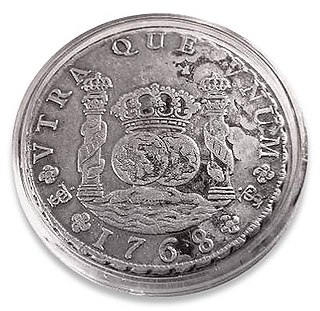
The real was a unit of currency in Spain for several centuries after the mid-14th century. It underwent several changes in value relative to other units throughout its lifetime until it was replaced by the peseta in 1868. The most common denomination for the currency was the silver eight-realSpanish dollar or peso which was used throughout Europe, America and Asia during the height of the Spanish Empire.
The real was the currency of Argentina until 1881. From 1822, it was subdivided into 10 décimos. The sol was also issued during this period and was equal to the real, whilst the peso was worth 8 reales and the escudo was worth 16 reales.
The livre was the currency of Haiti until 1813. The Haitian livre was a French colonial currency, distinguished by the use, in part, of Spanish coins. It was equal to the French livre and was subdivided into 20 sous, each of 12 deniers. The escalin of 15 sous was also used as a denomination, since it was equal to the Spanish colonial real. Coins specifically for use in Haiti were issued between 1802 and 1809, along with various overstamped coins.
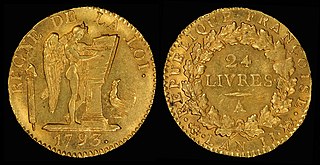
The livre was the currency of Kingdom of France and its predecessor states of Francia and West Francia from 781 to 1794. Several different livres existed, some concurrently. The livre was the name of coins and of units of account.
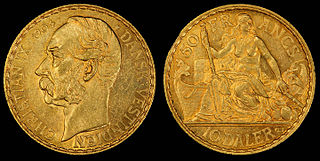
The daler was the currency of the Danish West Indies between 1849 and 1917, and of the United States Virgin Islands between 1917 and 1934.
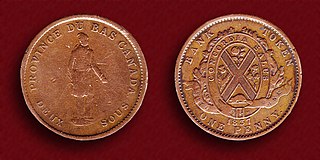
The pound was the currency of the Canadas until 1858. It was subdivided into 20 shillings (s), each of 12 pence (d). In Lower Canada, the sou was used, equivalent to a halfpenny. Although the £sd accounting system had its origins in sterling, the Canadian pound was never at par with sterling's pound.
The livre was the currency of New France, the French colony in modern-day Canada. It was subdivided into 20 sols, each of 12 deniers. The New France livre was a French colonial currency, distinguished by the use of paper money.
The history of currency in the British colony of Dominica closely follows that of the British Eastern Caribbean territories in general. Even though Queen Anne's proclamation of 1704 brought the gold standard to the West Indies, silver pieces of eight continued to form a major portion of the circulating currency right into the latter half of the nineteenth century.
The history of currency in the British colony of Grenada closely follows that of the British Eastern Caribbean territories in general. Even though Queen Anne's proclamation of 1704 brought the gold standard to the West Indies, silver pieces of eight continued to form a major portion of the circulating currency right into the latter half of the nineteenth century.
The Philippine real was the currency of the Philippines during the Spanish Colonial Era. Brought over in large quantities by the Manila galleons, eight silver reales made up a silver peso or a dollar. 16 silver real were equal to one gold escudo.
The history of currency in the British colony of St. Kitts closely follows that of the British Eastern Caribbean territories in general. Even though Queen Anne's proclamation of 1704 brought the gold standard to the West Indies, silver pieces of eight continued to form a major portion of the circulating currency right into the latter half of the nineteenth century.
The dollar was the currency of Nevis until 1830. The currency consisted of counterstamped Spanish and French colonial coins. The dollar was subdivided into 72 black dogs, each of 1½ pence. Around 1801, coins were issued for 1, 4, 6, 7 and 9 black dogs with the word "Nevis" and the denomination stamped on them. The 1 black dog coins were countermarked on French Guianan 2 sous, whilst the 9 black dogs were made from Spanish colonial 1 real coins. In 1830, sterling was established as the official currency of the island.
The history of currency in the British colony of Saint Vincent closely follows that of the British Eastern Caribbean territories in general. As such, it should not be considered in isolation. In order to get a broad overview of currency in the region, see the article British West Indies dollar.
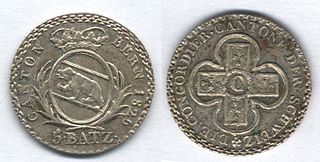
The Frank was the currency of the Swiss canton of Bern between 1798 and 1850. It was subdivided into 10 Batzen, each of 10 Rappen. It was worth 1⁄4th the French silver écu or 6.67 g fine silver.
The Fribourg Gulden was a currency denomination worth 14 Batzen of the Swiss canton of Fribourg until 1798.
The Geneva thaler was a coin equivalent to the French silver écu, containing 26.67 g fine silver and valued at 123⁄4florins, which was issued by Geneva until 1798 and between 1813 and 1839.
The livre was the currency of Guadeloupe until 1816. It was subdivided into 20 sous, each of 12 deniers, with the escalin worth 15 sous. The Guadeloupe livre was a French colonial currency, distinguished by the use, in part, of Spanish coins.
The history of currency in the British colony of Saint Lucia closely follows that of the British Eastern Caribbean territories in general. Even though Queen Anne's proclamation of 1704 brought the gold standard to the West Indies, silver pieces of eight continued to form a major portion of the circulating currency right into the latter half of the nineteenth century.






